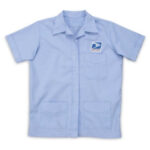Japanese school uniforms, or seifuku (制服), are more than just attire; they are a deeply ingrained aspect of Japanese culture, reflecting historical influences and evolving fashion trends. Rooted in the Meiji era and inspired by Western military dress, these iconic outfits have journeyed from symbols of discipline and conformity to fashion statements embraced globally. Let’s delve into the fascinating world of Imperial Japan School Uniforms and their enduring legacy.
Echoes of Military Influence in Traditional Uniforms
Image alt text: A male student’s gakuran uniform, showcasing the classic stand-up collar design characteristic of Imperial Japanese military-inspired school attire.
The genesis of the traditional Japanese school uniform is firmly planted in the late 19th century, a period of rapid modernization and Westernization during Imperial Japan. Seeking to modernize its education system, Japan drew inspiration from European models, including military academies. This influence is strikingly evident in the gakuran (学ラン), the standard uniform for boys. Modelled after Prussian military uniforms, the gakuran is typically black or navy blue, featuring a stand-up collar, often adorned with five gold buttons, and straight-legged trousers. The Imperial University, now the prestigious University of Tokyo, holds the distinction of being the first institution to adopt this military-style uniform in 1886, setting a precedent for junior high and high schools across the nation.
For girls, the iconic sailor uniform, or sailor fuku (セーラー服), emerged, drawing inspiration from the British Royal Navy uniforms. While St. Agnes’ University (Heian Jogakuin) in Kyoto is credited with pioneering the sailor uniform for girls around 1920, its widespread adoption solidified the military influence on Japanese school attire. The sailor fuku is characterized by its distinctive sailor-style collar, pleated skirt, and a necktie or scarf. Its global recognition was amplified by popular culture, most notably through the manga and anime series Sailor Moon, where the magical heroines famously sport variations of the sailor fuku. Adding subtle distinctions within schools, some institutions utilize ribbon colors to denote grade levels, with students progressing through colors like red, blue, and white as they advance each year.
The Rise of Blazer Styles: A Modern Uniform Evolution
Image alt text: A female student wearing a modern blazer-style school uniform, illustrating the shift towards Westernized designs in contemporary Japanese school fashion.
The 1980s marked a turning point in Japanese school uniform design, witnessing the ascent of the blazer style. This contemporary uniform moved away from overt military aesthetics, embracing a more Westernized, preppy look. Blazer uniforms typically feature a blazer with gold buttons and a school crest or emblem, often paired with checked trousers for boys and checked skirts for girls. This style evokes a sense of formality and sophistication, reminiscent of uniforms worn by athletes in opening and closing ceremonies of international sporting events.
The blazer uniform gained traction, potentially due to its perceived “smarter” appearance compared to the more traditional gakuran and sailor fuku. Its increasing popularity also reflects a broader trend of Western influence on Japanese fashion and culture during this period. Interestingly, the blazer style often blurs the lines between boys’ and girls’ uniforms, with schools sometimes opting for similar blazer designs in neutral colors like grey or navy blue for both genders, fostering a more unified aesthetic. Seasonal variations are also prominent in blazer uniforms, with lighter fabrics and short-sleeved shirts for summer and heavier materials and sweaters for winter, mirroring the practicality observed in traditional uniforms.
Fashion Fads and Individual Expression within Uniformity
Image alt text: Students in contemporary school uniforms featuring sweater vests, highlighting the incorporation of modern fashion elements into Japanese school uniform designs.
Despite the inherent uniformity, Japanese students have consistently sought avenues for self-expression within the boundaries of school regulations. Fashion trends have always played a role in subtly modifying the standard uniform silhouette. The 1990s witnessed the “loose socks” phenomenon among high school girls, characterized by extremely long, baggy socks paired with deliberately shortened skirts, pushing the limits of school dress codes. Boys, influenced by American hip-hop culture, adopted oversized shirts and pants, mirroring the baggy clothing trend prevalent at the time.
More recent fashion shifts have steered towards a sleeker, more refined look. Pastel colors and slim-fit designs have gained popularity, particularly among girls aiming for a more slender silhouette. Black knee-high socks have also emerged as a fashionable accessory. These trends demonstrate the dynamic interplay between broader fashion currents and the adaptation of school uniforms to reflect contemporary tastes.
Beyond Tradition: The Evolving Landscape of School Uniforms
Image alt text: A snapshot of high school girls in Shibuya, Tokyo in 2003, showcasing the “loose socks” fashion trend that exemplified student attempts to personalize their uniforms.
Interestingly, a growing number of junior high and high schools are moving away from mandatory uniforms altogether. In these institutions, students often opt for smart casual attire that resembles a uniform, striking a balance between personal style and a cohesive school atmosphere. This trend underscores a gradual shift towards valuing individual expression while maintaining a sense of decorum within the school environment. The enduring popularity of stylish school outfits has even spawned specialized shops catering to fashion-conscious students, particularly high school girls, and attracting even international tourists intrigued by this unique facet of Japanese youth culture.
Image alt text: A retail display of school uniforms in Japan, highlighting the commercial aspect of seifuku culture and their availability for purchase beyond school-issued garments.
The journey of the Japanese school uniform, from its military-inspired origins in Imperial Japan to its contemporary iterations, reflects a fascinating interplay of history, culture, and fashion. Whether embracing tradition or adapting to modern trends, seifuku remain an instantly recognizable and culturally significant symbol of student life in Japan, captivating global attention and sparking ongoing evolution.
Photo Credit
Store display: Ari Helminen

